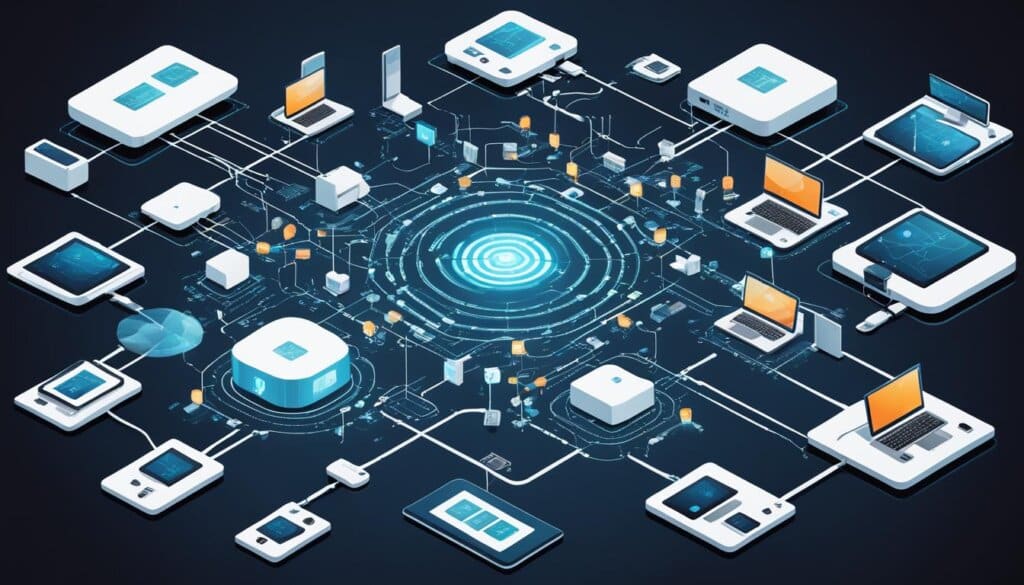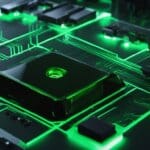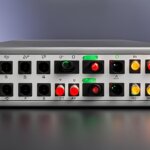Table of Contents
An edge device is any piece of hardware that controls data flow at the boundary between two networks. They serve as network endpoints and fulfill various roles such as transmission, routing, processing, monitoring, and storage of data. Edge devices are becoming more important with the rise of cloud computing and the internet of things (IoT) because they bring intelligence and computing power to the network edge through the concept of edge computing.
Some common types of edge devices include edge routers, firewalls, IoT devices, switches, and multiplexers. Edge devices have various use cases, including providing wireless capabilities, security functions, DHCP and DNS services, and enabling efficient data processing and storage closer to endpoints. They offer benefits such as expanded access, device management, improved regulatory compliance, and the ability to push intelligence to the periphery of the network. However, there are also challenges associated with edge devices, such as device management, security, bottlenecks, and the need for AI and ML capabilities.
Edge devices include a range of hardware and technology, and they play a crucial role in enabling edge computing.
What is Edge Computing and How Does it Work?
Edge computing is a distributed IT architecture that processes client data at the periphery of the network, close to the originating source. It moves storage and compute resources out of the central data centre and closer to the data source itself. By performing processing and analysis at the edge, edge computing reduces bandwidth limitations, latency issues, and network disruptions. It reshapes IT and business computing by bringing data processing closer to the data source.
Edge computing works by placing edge devices, such as edge servers and processors, at the network edge. These devices provide physical connectivity to both networks and allow traffic to traverse the two networks when necessary. They can forward IP packets, perform protocol translation, and offer AI and machine learning capabilities.
Edge computing is important because it addresses the challenges of handling large volumes of data generated by IoT devices and enables real-time processing and response. It offers a solution to the strain on the global internet and supports time-sensitive applications like self-driving cars.
Edge computing is not the same as cloud computing or fog computing, although there is some overlap between these concepts. Cloud computing is a centralized deployment of compute and storage resources, while fog computing combines edge and cloud computing for distributed processing.
Benefits of Edge Computing
- Reduced bandwidth limitations and latency issues
- Real-time processing and response
- Improved performance and efficiency
- Enhanced security and privacy
- Support for time-sensitive applications
Use Cases for Edge Computing
- Connected vehicles and autonomous driving
- Industrial automation and manufacturing
- Smart cities and infrastructure
- Remote monitoring and surveillance
- Healthcare and telemedicine
Edge computing brings data processing closer to the network edge, enabling faster and more efficient data analysis and response.
Types of Edge Computing Devices
In the world of edge computing, a variety of devices play a crucial role in enabling efficient data processing and storage closer to endpoints. Let’s explore the five main types of edge computing devices:
- IoT Sensors: These devices are an integral part of the edge ecosystem. They collect data on various critical metrics such as temperature, pressure, and motion. IoT sensors enable real-time monitoring and data collection, facilitating informed decision-making.
- Smart Cameras: Equipped with AI and machine learning technologies, smart cameras process visual information on-site. They provide real-time analysis without the need to transfer large volumes of footage to the central cloud. This approach minimizes latency, conserves network resources, and enhances security.
- Servers: Edge servers are powerful computers strategically placed at different points along the edge spectrum. These devices offer enhanced compute and storage capabilities, making them suitable for applications that demand higher processing power than other edge devices.
- Processors: CPUs, GPUs, and specialized processors are essential components of edge computing systems. They support the performance and operations of edge devices by efficiently executing complex tasks and data processing operations.
- Universal Customer Premises Equipment (uCPE): uCPE devices replace traditional customer premises equipment and incorporate software such as Virtual Network Functions (VNFs). These devices perform various network functions and services, enabling efficient data collection, processing, and transmission in the edge ecosystem.
These edge computing devices can be deployed either in edge data centers or on customer premises, depending on the specific use case. They collectively enable a wide range of edge computing applications, empowering organizations to process and analyze data at the edge, closer to the data source.

Comparison of Edge Computing Devices
| Device Type | Main Features | Deployment |
|---|---|---|
| IoT Sensors | Data collection: temperature, pressure, motion | Edge data centers, customer premises |
| Smart Cameras | Real-time visual analysis, AI-powered | Edge data centers, customer premises |
| Servers | High compute and storage capabilities | Edge data centers |
| Processors | CPU, GPU, specialized processors | Edge data centers, customer premises |
| uCPE | Virtual Network Functions, network services | Edge data centers, customer premises |
These edge computing devices collectively contribute to the effectiveness and resilience of edge computing strategies, enabling organizations to harness the full potential of edge computing technology.
The Importance of Edge Computing Devices
Edge computing devices play a crucial role in enabling edge computing, a distributed architecture that brings compute and storage resources closer to the data source. By processing data at the edge, these devices alleviate the strain on the global internet and facilitate real-time processing and response. This is particularly vital for time-sensitive applications like self-driving cars, where immediate decision-making is paramount.
Edge computing devices, such as IoT sensors and smart cameras, offer real-time analysis and insights without the need to transfer all the data to centralized cloud servers. This localized processing leads to improved efficiency, reduced latency, and optimized network resources utilization. As a result, these devices are reshaping IT and business computing, providing a more efficient and effective way to handle the ever-increasing data demands of modern businesses.
With edge computing devices, organizations can process data at the edge, closer to the data source, enabling actionable insights and real-time control over critical business processes and operations. This transforms the way businesses operate, delivering enhanced agility, improved decision-making, and better customer experiences. Edge computing devices are a key component of the edge ecosystem and are driving the growth and adoption of edge computing across various industries.
FAQ
What are edge devices in technology?
Edge devices are hardware that control data flow at the boundary between two networks. They serve as network endpoints and fulfill various roles such as transmission, routing, processing, monitoring, and storage of data.
What is edge computing and how does it work?
Edge computing is a distributed IT architecture that processes client data at the periphery of the network, close to the originating source. It moves storage and compute resources out of the central data center and closer to the data source itself, reducing bandwidth limitations, latency issues, and network disruptions.
What are the types of edge computing devices?
The main types of edge computing devices include IoT sensors, smart cameras, servers, processors, and universal customer premises equipment (uCPE). These devices enable data collection, processing, and transmission in the edge ecosystem.
Why are edge computing devices important?
Edge computing devices play a crucial role in enabling edge computing, which supports distributed computing and brings compute and storage resources closer to the data source. They reduce strain on the global internet, enable real-time processing, and support time-sensitive applications like self-driving cars.












